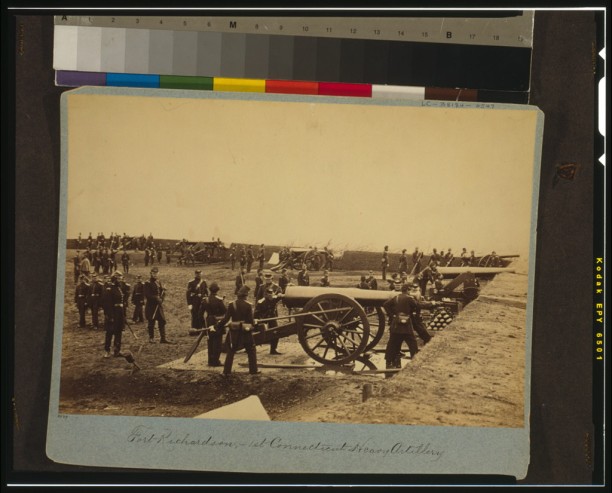Last Updated: September 19, 2024
By Matthew Warshauer
Connecticut has a remarkable Civil War history. Although it is a small state, it was in many ways instrumental to the Union’s survival. The history of the Civil War surrounds Connecticut residents every day both in terms of its physical realities and in the lasting legacies of a complicated conflict that shook the nation between 1861 and 1865.
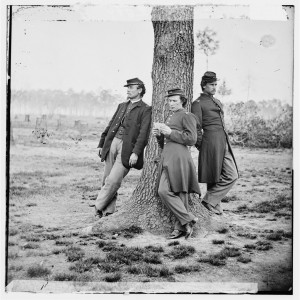
Three officers of Company C, 1st Connecticut Heavy Artillery, Fort Brady, Virginia 1864 – Library of Congress, Prints and Photographs Division. Used through Public Domain.
Lasting Legacies of a Complex War
Connecticut is home to more than 130 Civil War monuments. They adorn the centers of cities such as Hartford and Waterbury, dot small town greens from Branford to Northfield, and stand silently in sacred places like West Cemetery in Bristol and the Congregational Church in Kensington. Indeed, the Kensington monument—an obelisk made of Portland brownstone designed by Nelson Augustus Moore and dedicated in 1863—is the oldest in the north and one of the oldest in the nation. Like these tangible memorials of the war, the legacies connected to race and slavery have continued well into the 21st century. In 2009, the Connecticut General Assembly passed a resolution apologizing for the state’s involvement in and support of slavery.
The connection between slavery and the Civil War is both obvious and complicated. It is obvious because the line that separated North from South was principally one where slavery began or ended, and, of course, the final result of the war was the death of the “peculiar institution,” as slavery was sometimes called. Yet, the conflict is complicated because few in the North (including Connecticut) entered the war to emancipate enslaved people. The majority of Connecticut’s residents were not abolitionists. Again, the state’s Civil War monuments are instructive. Only three—the Sailors and Soldiers Memorial Arch in Hartford (1886), the Waterbury Soldiers’ Memorial (1884), and the Connecticut 29th Colored Regiment in New Haven (2008)—have any connection to race or slavery. The majority of the state’s monuments are testaments to sacrifice and the Union.
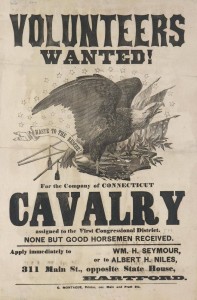
Call for volunteers to a Connecticut cavalry unit, 1861 – Connecticut Museum of Culture and History. Used through Public Domain.
And yet the human sacrifice that the war required came home to Connecticut, as it did to every state. Some 55,000 Connecticut men joined the Union Army, a number which represented 47% of men between the ages of 15 and 50. Ten percent of these men died and many more suffered horrible wounds and the lasting memories of watching family and friends perish. Connecticut fielded 30 regiments, as well as cavalry and artillery units. This included one full African American regiment, the 29th Colored Regiment, as well as the beginnings of the 30th Colored Regiment, which was ultimately folded into the 31st Regiment United States Colored Infantry. The level of Black participation in Connecticut regiments was astounding, considering that the 1860 Federal Census revealed only 8,726 Black people living in the state, and of them only 2,206 were men between the ages of 15 and 50 (the most likely ages for service). Seventy-eight percent of eligible Black men enrolled in the 29th and 30th regiments. Just over 15% of these men died as a result of the war.
Connecticut Takes to the Battlefield
The state’s soldiers fought in every major engagement of the war: from Bull Run to Antietam and Gettysburg, in General William Tecumseh Sherman’s march on Atlanta and through the Carolinas, to the final days before Petersburg and Richmond. They wrote home, complained of army life, worried about their families, expressed their torment and frustration when battles went poorly, and questioned the war’s meaning as they saw comrades blown to pieces.
Perhaps the most famous and hardest-hit regiment was the Connecticut 14th, which arrived at Antietam (September 17, 1862), the single bloodiest battle of the war, after only a few weeks of training. Samuel Fiske, a member of the 14th and a minister from Madison, Connecticut, wrote home about the Maryland battle on September 18: “I have at last turned over a new and bloody leaf in my experience, and seen a battle, and am now writing you, sitting in a newly plowed field all strewn with the dead of our gallant Union soldiers, still unburied, lying as they fell.” The regiment suffered again only a few months later in Virginia at Fredericksburg (December 11-15, 1862). Fiske wrote on the last day of that battle, “Oh! My heart is sick and sad. Blood and wounds and death are before my eyes; of those who are my friends, comrades, brothers…. Another tremendous, terrible, murderous butchery of brave men.”
Finally, at Gettysburg, the 14th gained some degree of redemption. Protecting one of the most important points of the Union line, the men withstood Confederate Major General George Pickett’s famous charge on July 3, 1863, leaped over a stone wall, and captured six enemy battle flags. Three men from the regiment (Elijah W. Bacon, Christopher Flynn, and William B. Hincks) received the Congressional Medal of Honor for valor. The once disheartened Sam Fiske exulted in the victory, writing on July 4th, “I have at last had the desired opportunity of seeing a battle in which there was real fighting; hard, persistent, desperate fighting; a fighting worthy of a noble cause and the confidence of a gallant people….Hurrah for the gallant old 14th!”
Such stories of suffering and victory were repeated by Connecticut men serving in regiments spread throughout the nation—in the west at Vicksburg, Mississippi, in the deep south of Louisiana, in Florida, the Carolinas, and in the defenses around Washington, D.C. Yet, as much as these men suffered in the cause of war, those at home suffered too. Women gave constant attention to the needs of the soldiers in the field, and a virtual river of supplies poured through Connecticut’s soldiers’ aid societies.
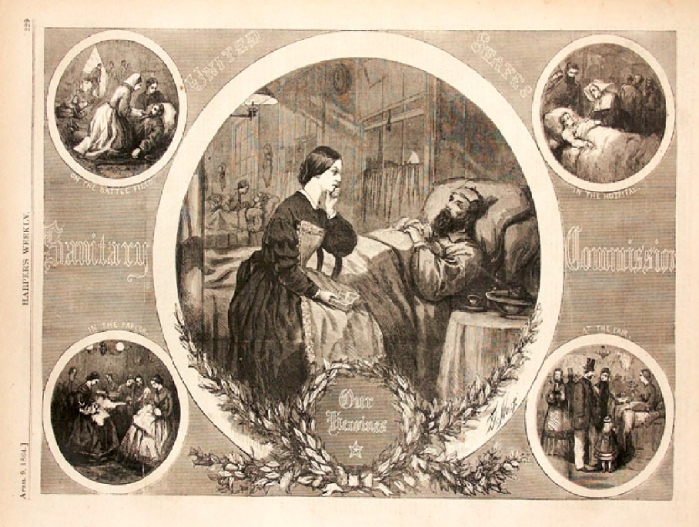
Civil War Sanitary Commission, Harpers Weekly, April 9, 1864 – Brooklyn Museum Libraries. Used through Public Domain.
On the Home Front
The Hartford Soldiers’ Aid Society became the central organizing body for all other state aid societies. Its first president, Sarah S. Cowen, constantly peppered newspapers with appeals, writing to the Hartford Daily Courant in May 1863, “It is hoped that the battles which are now being fought, and those constantly impending, may stimulate the humane public to new efforts in behalf of our sick and wounded soldiers.” The societies raised money, collected a wide assortment of garments, medical supplies, and books, as well as food. They collected just about every conceivable item and often received letters from soldiers, as well as regimental chaplains and surgeons, requesting specific materials.
On occasion, women slipped notes into boxes or garments. Ellen M. Sprague of Andover stuffed the following into a sock:
“My dear Friend and brother in our Country’s cause: To your care and keeping I commit these socks, and trust they may never be disgraced by any conduct of their wearer. Loyal fingers fashioned them, and may a patriot’s tread, whose very step shall tell against our rebel foes, wear them threadbare (if need be) in crushing the wicked rebellion. In every stitch is knit a prayer for our nation’s weal, and the hope that peace may smile upon our land long ere these be unfit for use.” (Her letter was published in The Courant in March 1863.)
Women also traveled to battlefields before the cannons had cooled to care for the sick and wounded. They met troop trains arriving in Connecticut and helped set up hospitals to care for the men. They attended funeral after funeral. No one in Connecticut escaped the ravages of war.
Connecticut’s War Industry
The home-front effort was not solely about the relief of suffering or providing the material comforts of home to those on the battlefield. Another part of Connecticut’s workforce diligently produced every means of destruction. Home to a remarkable array of arms and munition companies, the Nutmeg State was a virtual arsenal. The most well-known manufacturers are Colt’s Patent Fire-Arms Manufacturing Company (Hartford), Eli Whitney Jr. Company (New Haven), Sharps Rifle Manufacturing Company (Hartford), and Savage Revolving Fire Arms (Middletown). Yet, there were others in the state, such as the Connecticut Arms Company in Norfolk, William Muir in Windsor Locks, and the Norwich Arms Company. There were also a host of smaller subcontractors.
Additionally, firms like Collins & Company, in Collinsville—the same company that had made a portion of John Brown’s infamous pikes for his 1859 raid on the federal armory in Harper’s Ferry, Virginia—produced swords and bayonets. Hotchkiss & Sons in Sharon manufactured all sorts of newly designed artillery shells. Arms historian David J. Naumec wrote, “Connecticut’s firearms industry achieved an unrivaled degree of success during the Civil War, manufacturing enough firearms to equip a large portion of the Union armies.” Many of the state’s manufacturers were also innovators. Between 1862 and 1863, more than 70 patents were issued to Connecticut inventors, the vast majority, some 75%, for weaponry.
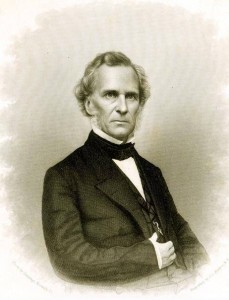
William A. Buckingham, Connecticut’s governor throughout the Civil War – By John Chester Buttre. Connecticut Museum of Culture and History. Used through Public Domain.
A State Divided
The massive outpouring of support for the war makes it seem like Connecticut was largely unified in its dedication to the Lincoln administration and the war effort, but nothing could be further from the truth. Nearly half of Connecticut’s population was steadfastly opposed to fighting the South. The state descended into chaos at the start of the war, splitting into warring Republican and Democratic factions that sometimes faced off violently. Before the Southern states even seceded, the two parties faced off in the 1860 gubernatorial election, a contest that would decide the level of the state’s involvement once the war began.
Democrats pitted the popular former governor Thomas H. Seymour against Republican Governor William A. Buckingham. Fearing defeat, the Republican party pulled Abraham Lincoln from his travels in New York and New Hampshire to deliver five speeches in Connecticut in March 1860. Buckingham won the election by a mere 541 votes, receiving 44,458 to Seymour’s 43,917, with some 10,000 more votes cast than in the previous year’s election.
Opposition Calls for Peace
When the war finally began in April 1861, Democrats immediately opposed it. A white “peace” flag appeared in Ridgefield, where two men were shot while attempting to tear it down. Other peace flags were put up in Avon, New Milford, New Preston, Windsor, and West Hartford. Upon hearing such reports, Thomas Seymour, then serving in the General Assembly, announced that there existed “a growing sentiment among the people for a peaceful settlement—and honorable peace.” He insisted that the South could not be forced back into the Union and was quoted in The Hartford Weekly Times saying, “There seems to be a radical mistake on the part of many people. They appear to think the South can be conquered.”
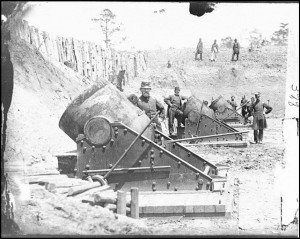
13-inch seacoast mortars of Federal Battery No. 4 with officers of 1st Connecticut Heavy Artillery, near Yorktown, Virginia, 1862 – Library of Congress, Prints and Photographs Division. Used through Public Domain.
Although the raising of peace flags and violent opposition in the streets declined over the course of the war, the animosity and struggle for political control continued. Most significant was the 1863 gubernatorial election, which once again placed Governor Buckingham against Seymour. Had Buckingham lost this pivotal election, his defeat could have ended Connecticut’s support for the Lincoln administration and the Union. The focal point of the contest became the opinions of soldiers at the front. The Courant and The Hartford Times published dozens of soldiers’ letters and regimental resolutions advocating either Buckingham or Seymour for governor. It was one of the most concentrated, sustained political effort of the war.
A soldier from the 27th Regiment wrote, in a letter published in The Courant, “I hope, in all favor, that our friends will not allow Tom Seymour to be elected Governor of Connecticut. Don’t do it! For mercy’s sake, don’t let him be Governor.” A soldier from the 22nd shot back, “Almost to a man, rank and file, heartily endorse the nomination of Gov. Seymour, and daily wish and pray that he may be elected.” Ultimately, Buckingham won the election by just 2,634 votes, almost precisely the number of Union soldiers furloughed to return home and cast ballots. Democrats charged fraud, and the uneasy dispute over the war continued well through its end.
To some extent, the differences between Republicans and Democrats grew to encompass the issue of race. Though Republicans had generally not entered the war to free America’s nearly four million enslaved people, once the conflict was in earnest, emancipation became a means to win.
Emancipation vs. Abolition
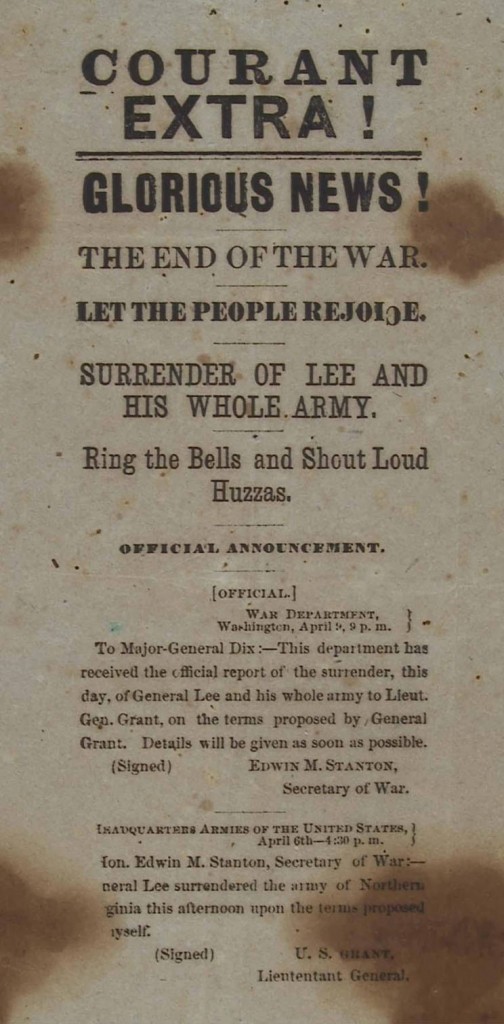
Handbill issued by The Hartford Courant in April 1865 that signaled the end of the Civil War – Connecticut Museum of Culture and History. Used through Public Domain.
Lincoln’s Emancipation Proclamation sapped the South of its labor force, and Republicans came to accept this necessity. Democrats utterly refused and railed against a war waged for abolition. The reality, however, was that emancipation and abolition were not the same.
Emancipation placed the needs of the Union ahead of the needs of enslaved people; it was not about Black social and political equality. In contrast, abolition focused on equality and human rights, and, in the minds of many, endangered the Union. Lincoln had famously stated, “If I could save the Union without freeing any slave I would do it, and if I could save it by freeing all the slaves I would do it; and if I could save it by freeing some and leaving others alone I would also do that.” This was the difference between emancipation and abolition, and it accurately reflected many attitudes in Connecticut.
In the spring of 1865, the Connecticut General Assembly passed an amendment to the state constitution removing the word “white” in determining who could vote, and scheduled an October referendum on the subject. The change was overwhelmingly rejected by Connecticut voters—it was Republican votes that secured the amendment’s defeat. The state’s residents may have ultimately supported emancipation, but they were not all advocates of Black civic equality—many were not abolitionists.
This legacy of racial intolerance, as well as that of the sacrifices of Connecticut soldiers and those on the home front, is symbolized in the state’s Civil War monuments. While the road to Civil War was complex, slavery and the right to enslave people were central causes of the war. Individuals in Connecticut, however, fought and formed their support (or lack thereof) for the Union based on a variety of factors.
Matthew Warshauer, PhD, is a Professor of History at Central Connecticut State University.
This article has been updated, learn more about content updating on ConnecticutHistory.org here.





